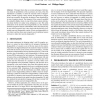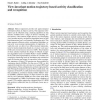700 search results - page 88 / 140 » Transducing Markov sequences |
ECAI
2008
Springer
13 years 10 months ago
2008
Springer
Abstract. This paper shows that we can take advantage of information about the probabilities of the occurrences of events, when this information is available, to refine the classic...
ATAL
2007
Springer
14 years 2 months ago
2007
Springer
Activity recognition is a key component for creating intelligent, multi-agent systems. Intrinsically, activity recognition is a temporal classification problem. In this paper, we...
AIPS
2000
13 years 10 months ago
2000
1 We consider the problem of scheduling an unknown sequence of tasks for a single server as the tasks arrive with the goal off maximizing the total weighted value of the tasks serv...
BMCBI
2006
13 years 8 months ago
2006
Background: Hidden Markov Models (HMMs) have been extensively used in computational molecular biology, for modelling protein and nucleic acid sequences. In many applications, such...
MMS
2006
13 years 8 months ago
2006
Motion trajectories provide rich spatio-temporal information about an object's activity. The trajectory information can be obtained using a tracking algorithm on data streams ...


